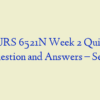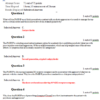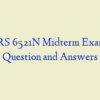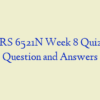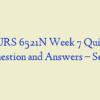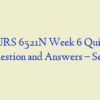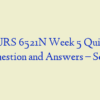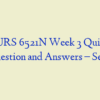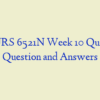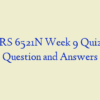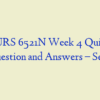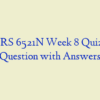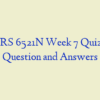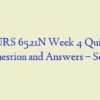Description
NURS 6521C Midterm Exam – NURS 6521D – NURS 6521N Midterm Exam 2 – Advanced Pharmacology (95/100)
- In order to promote therapeutic drug effects, the Nurse Practitioner should always encourage patients to
- A female patient with a diagnosis of type 1 diabetes mellitus has been experiencing increasing neuropathic pain in recent months, a symptom that has not responded appreciably to conventional analgesics. The patient’s care provider has begun treatment with gabapentin (Neurontin). How is the addition of this drug likely to influence the management of the patient’s existing drug regimen?
- Following an assessment by her primary care provider, a 70-year-old resident of an assisted living facility has begun taking daily oral doses of levothyroxine. Which of the following assessment findings should prompt the nurse to withhold a scheduled dose of levothyroxine?
- The lower respiratory system utilizes a number of different mechanisms that confer protection and maintain homeostasis. Which of the following physiological processes protects the lower respiratory system?
- A 62-year-old man has been prescribe lovastatin. The Nurse Practitioner will instruct the patient to take the medication
- A Nurse Practitioner who provides care for older adults is aware of the high incidence of drug interactions in this population. When educating a group of seniors about the prevention of drug interactions, the Nurse Practitioner should encourage them to
- A Nurse Practitioner is teaching an older adult patient about polypharmacy. Which of the following statements best describe this term?
- A diabetic patient being treated for obesity tells the Nurse Practitioner that he is having adverse effects from his drug therapy. The patient has been taking dextroamphetamine for 2 weeks as an adjunct therapy. Which of the following adverse effects would need the Nurse Practitioner’s immediate attention?
- A 22-year-old patient is transitioning from oral agents to insulin. He will be taking 20 units of Lantus at bedtime and regular insulin before meals. What instructions should the NP provide about the timing and dose of regular insulin?
- Topical inhaled alpha adrenergic blocking agents or nasal vasoconstricting decongestants should not be used chronically (>5 days) because they can cause
- The parents of a 7-year-old boy who has just been diagnosed with allergic asthma are being taught about their son’s medication regimen by the nurse. The nurse is currently teaching the parents about the appropriate use of a “rescue drug” for acute exacerbations of their son’s asthma. What drug should the nurse suggest the parents to use in these situations?
- A 70-year-old woman with a history of atrial fibrillation takes digoxin and verapamil to control her health problem. Verapamil achieves a therapeutic effect by
- A patient receives 25 units of NPH insulin at 7.AM. At what time of day should the nurse advise the patient to be most alert for a potential hypoglycemic reaction?
- A child with sinusitis has been on antibiotics for seven days and his symptoms are not improving. All of the following are options to prescribe for the patient now EXCEPT:
- The Nurse Practitioner’s assessment of a community-dwelling adult suggests that the client may have drug allergies that have not been previously documented. What statement by the client would confirm this?
- A homeless man who is well known to care providers at the local hospital has been admit to the emergency department after having a seizure outside a mall. The man is known to be a heavy alcohol user and is malnourished with a very low body mass index. How are this patient’s characteristics likely to influence possible treatment with phenytoin?
- A patient has been prescribe a histamine-2 (H2) receptor antagonist for the treatment of GERD. Why are H2RAs more effective than H1 receptor antagonists in the treatment of diseases of the upper GI tract?
- A 24-year-old factory worker has been prescribe guaifenesin for the first time. Which of the following will be a priority assessment by the nurse before the patient’s first dose?
- In light of her recent high blood pressure readings, a patient has been start on a thiazide diuretic and metoprolol (Lopressor), which is a beta-adrenergic blocker. What is the most likely rationale for using two medications to address the patient’s hypertension?
- A woman with numerous chronic health problems has been diagnosing with a benign gastric ulcer has begun treatment with ranitidine (Zantac). Which of the following teaching points should the nurse provide to this patient?
- The APRN should educate a diabetic patient that beta-blockers may mask the signs and symptoms of
- A patient has been prescribe a drug that can be self-administered at home. Which of the following would be the most important information for the nurse to relate to the patient concerning self-administration of a drug?
- Advanced practice nurse prescribing of schedule medications is affected most by:
- The APRN is treating a patient with type 2 diabetes. The patient is on the maximum dose of metformin and glucotrol. Current weight 212 pounds. Labs from this morning indicate a fasting blood sugar of 312 and HbA1C of 9. The APRN wants to start the patient on Lantus 0.2 unit/kg. What dose and instructions should the APRN provide? (NURS 6521C Midterm Exam)
- A 75-year-old woman is prescribe magnesium hydroxide for constipation. The nurse’s assessment reveals that the patient is being treated for rheumatoid arthritis and hypertension. The patient lives in assisted living and is on a low-sodium diet. Before the magnesium hydroxide therapy begins, it will be most important for the nurse to assess the patient’s
- A female patient is taking 0.125 mg of digoxin daily for heart failure. At a recent clinic visit, she reports that since she has been on the drug, she can breathe better and her heart rate has been around 74 beats per minute. The nurse weighs the patient and notices that she has gained 10 pounds since the digoxin therapy was started. The patient is concerned that the additional weight will necessitate an increase in the medication. Which of the following is an appropriate response by the nurse?
- A 72-year-old man is prescribed theophylline for symptomatic relief of bronchial asthma. Which of the following findings would alert the nurse to the need for close monitoring?
- A patient has a history of tonic-clonic seizures that have been successfully treating with phenytoin (Dilantin) for several years.
- Phenytoin achieves a therapeutic effect by
- A man who smokes one pack of cigarettes daily has been diagnose with chronic bronchitis. He has been prescribed theophylline by his family doctor. What effect will the patient’s smoking status have on the therapeutic use of theophylline?
- A 56-year-old female patient has been admitting to the hospital with chronic muscle spasms and has been prescribed a new medication to treat the spasms. She has a poorly documented allergy to eggs, synthetic clothes, and perfumes. What is the priority action of the nurse to ensure that prescribed medication does not experience an allergic reaction?
- A Nurse Practitioner is instructing a patient concerning a newly prescribed drug.
- Which of the following should be included to help improve patient compliance and safety? (NURS 6521C Midterm Exam)
- A home health Nurse Practitioner is performing a home visit to an elderly client who has early-stage dementia. The Nurse Practitioner observes that some of the client’s pill bottles are empty, even though the client is not due for refills for 2 weeks. What nursing diagnosis should the Nurse Practitioner prioritize when planning this client’s care?
- Mr. Nguyen, age 71, will soon be discharged home from the hospital after a successful coronary artery bypass graft (CABG). During patient education about his drug regimen, Mr. Nguyen’s nurse should prioritize teach about
- A woman has a long history of seasonal allergies that are typically accompanied by rhinorrhea, red eyes, and frequent sneezing. Sneezes are a result of
- A 34-year-old male patient is prescribe methimazole (MMI). The Nurse Practitioner will advise him to report which of the following immediately?
- A patient with a long history of alcohol abuse has been admitted to an acute medical unit with signs and symptoms of hepatic encephalopathy. His current medication orders include QID doses of oral lactulose. What desired outcomes should the nurse associate with this drug order?
- The Nurse Practitioner is treating a patient that takes frequent doses of antacids for his heartburn and is also taking an enteric coded aspirin.
- What instructions should be provide to the patient?
- To minimize the risk of adverse effects of glucagon when given to an unconscious diabetic patient, as the patient regains consciousness, the nurse should
- An expected outcome for a patient who has just taken sublingual nitroglycerin should be
- A 72-year-old man is taking Adderall XR for the treatment of narcolepsy. He is currently having problems with not being able to swallow large tablets or capsules. The man also wears dentures, which makes it even more difficult for him to swallow medication. He is in the clinic to talk to the nurse about his problem. The nurse will instruct him to
- Mrs. Houston is a 78-year-old woman who resides in an assisted living facility. Her doctor prescribed digoxin at her last visit to the clinic and she has approached the nurse who makes regular visits to the assisted-living facility about this new drug. What teaching point should the nurse emphasize to Mrs. Houston? (NURS 6521C Midterm Exam)
- What critical piece of information is missing from the following medication order: Amoxicillin 250 mg every 8 hours?
- A male patient is to begin glyburide (Diabeta) for type 2 diabetes. Before the drug therapy begins, a priority action by the nurse will be to assess the patient’s
- The Nurse Practitioner is performing patient education for a woman who will soon begin treatment of hyperlipidemia with simvastatin (Zocor). The patient has asked the Nurse Practitioner if there are any “bad side effects” that she should be aware of. Which of the following statements should underlie the nurse’s response?
- A 66-year-old woman has a complex medical history that includes poorly-controlled type 1 diabetes, renal failure as a result of diabetic nephropathy and chronic heart failure (CHF). Her care provider has recently added spironolactone (Aldactone) to the woman’s medication regimen.
- The nurse should consequently assess for signs and symptoms of
- A Nurse Practitioner is caring for a 70-year-old patient who is taking desmopressin (DDAVP). The patient has a history of cardiovascular disease. The nurse will prioritize the assessment of which of the following?
- A Nurse Practitioner is providing care for a patient who suffer extensive burns to his extremities during a recent industrial accident. Topical lidocaine gel has been ordered to be applied to the surfaces of all his burns in order to achieve adequate pain control. When considering this order, the Nurse Practitioner should be aware that
- A Nurse Practitioner receives an order to administer a critically ill patient two drugs immediately (stat). The Nurse Practitioner begins the process by
- A patient has been admit to the ICU because of multiple traumas due to a motor vehicle accident. The physician has ordered propofol (Diprivan) to be used for maintenance of sedation. Before administration of propofol, a priority assessment by the nurse would be to check for a history of. (NURS 6521C Midterm Exam)
- A female patient has been taking prednisone for her asthma for 1 month. The nurse will teach her to gradually decrease her dose of prednisone to avoid
- A Nurse Practitioner is providing a patient with a list of drugs as a part of the patient’s plan of care. Which of the following drug nomenclatures should the Nurse Practitioner use to list the drugs?
- A clinic Nurse Practitioner has been assigne a 49-year-old female patient who has a history of diabetes. A recent diagnosis of hypertension has been made, and the patient has been prescribe a thiazide diuretic and labetalol. The patient will be schedule to return to the clinic once a month for the next 6 months. A priority action by the Nurse Practitioner will be to
- A patient has GERD and is taking ranitidine (Zantac).
- She continues to have gastric discomfort and asks whether she can take an antacid. Which of the following is an appropriate response by the nurse?
- Which of the following statements best defines how a chemical becomes termed a drug?
- A Nurse Practitioner is caring for a 73-year-old man who is receiving drug therapy. He is beginning to exhibit signs of decline in his renal system, yet his current serum creatinine level is normal. The Nurse Practitioner will base the patient’s plan of care on the understanding that there is
- A 46-year-old white American has been prescribe a drug that binds to acid glycoproteins. The nurse understands that white Americans usually receive
- Which of the following would be an expected outcome in a patient who has been given atropine during a medical emergency?
- A nurse practitioner understands when prescribing a medication that there are certain questions to address. Check all that apply.
- The APRN is prescribing a medication that is known to induce hepatic enzymes. What effect should you anticipate?
- A 49-year-old woman has been diagnose with myalgia. The physician has recommended aspirin. The patient is concerned that the aspirin will upset her stomach. The nurse will encourage the patient to. (NURS 6521C Midterm Exam)
- It is determined that a patient, who is in a hepatic coma, needs a laxative. Lactulose is prescribed. Which of the following should the nurse monitor to assess the efficacy of the lactulose therapy?
- Drugs have a high potential for abuse. There is no routine therapeutic use for these drugs and they are not available for regular use. They may be obtained for “investigational use only” by applying to the U.S. Drug Enforcement Agency.
- Examples include heroin and LSD. Which scheduled drug is this?
- A Nurse Practitioner is a member of a research team that is exploring unique differences in responses to drugs that each individual possesses, based on genetic make-up. This area of study is called
- The Nurse Practitioner is prescribing Salmeterol (Serevent) inhaler for a patient with asthma. What instructions would be correct to provide the patient?
- A patient with a recent diagnosis of acute renal failure has a long-standing seizure disorder which has been successfully controlled for several years with antiseizure medications. The nurse should recognize that the patient’s compromised renal function will likely
- A mother brings her 4-year-old child, who is vomiting and has a temperature of 103°F into the emergency department (ED). The ED physician orders acetaminophen (Tylenol) for the fever. The best form of Tylenol to give the child, considering her presentation, would be
- A 20-year-old woman calls the clinic at 5 PM and reports to the Nurse Practitioner that she forgot to take her morning dose of fexofenadine (Allegra). She usually takes her evening dose at 8 PM. She wants to know what she should do. The Nurse Practitioner will instruct her to
- A Nurse Practitioner is the cardiac care unit is preparing to hang an intravenous dose of dofetilide (Tikosyn) for a patient who has just been admitted. What is the most likely goal of this intervention? (NURS 6521C Midterm Exam)
- A patient in need of myocardial infarction prophylaxis has been prescribed sulfinpyrazone for gout. Which of the following will the nurse monitor the patient most closely for?
- A 33-year-old woman has irritable bowel syndrome (IBS). The physician has prescribed simethicone (Mylicon) for her discomfort. Which of the following will the nurse monitor most closely during the patient’s drug therapy?
- Which of the following is TRUE about long acting beta agonist use in asthma patients?
- A 79-year-old woman with a medical history that includes osteoporosis has recently moved to a long-term care facility. Medication reconciliation indicates that the woman has been taking calcitonin, salmon for several years. The nurse should recognize that the most likely route for the administration of this drug is
- A 58-year-old man is prescribe dicyclomine (Bentyl) for irritable bowel syndrome. In which of the following conditions is dicyclomine therapy contraindicate?
- A 62 year old male who had a myocardial infarction one year ago is being seen for hypertension. Which medication has the best evidence in mortality reduction? (NURS 6521C Midterm Exam)
- A patient is taking cholestyramine. The Nurse Practitioner will assess for which of the following common adverse effects of the drug?
- A Nurse Practitioner is caring for a patient who has recently move from Vermont to south Florida. The patient has been on the same antihypertensive drug for 6 years and has had stable blood pressures and no adverse effects. Since her move, however, she reports “dizzy spells and weakness” and feels that the drug is no longer effective. The Nurse Practitioner suspects that the change in the effectiveness of the drug is related to
- A patient with diabetes has had a cough for 1 week and has been prescribe a cough syrup (an expectorant). What special instructions should the nurse include in the patient teaching for this situation?
- A Nurse Practitioner who is responsible for administering medications should understand that the goals of the MedWatch program are to (Select all that apply.)
- A patient is bother with nighttime episodes of bronchoconstriction relate to asthma. Which of the following medications can be administer to decrease the nighttime episodes and prevent asthma attacks?
- Mr. Lacuna is an 83-year-old resident of a long-term care facility who has a diagnosis of moderate Alzheimer disease.
- Mr. Lacuna’s physician recently prescribed oral rivastigmine, but he was unable to tolerate the drug due to its gastrointestinal effects. As a result, he has been ordered the transdermal patch form of the medication. When administering this form of rivastigmine, the nurse should
- After a recent history of shortness of breath that has become increasingly severe, a woman has been prescribed ipratropium by MDI while she undergoes a diagnostic workup. What patient teaching should the nurse provide to this patient?
- During a clinic visit, a patient complains of having frequent muscle cramps in her legs. The nurse’s assessment reveals that the patient has been taking over-the-counter laxatives for the past 7 years. The nurse informed the patient that prolonged use of laxatives
- A Nurse Practitioner is instructing a patient who was recently diagnose with multiple sclerosis about dantrolene (Dantrium). The patient is a 38-year-old-male and the foreman for a construction company. In order to minimize one important adverse effect of the drug, the nurse will give the patient which of the following instructions?
- A 62-year-old man is admit to the hospital with a diagnosis of chest pain. He has an order for 0.3 mg of sublingual nitroglycerin prn for chest pain. Which of the following actions should the nurse do first when he complains of chest pain?
- A 60-year-old African-American man lives with a number of chronic health problems. Genetic factors are likely to influence his etiology and/or treatment of
- A 22-year-old male college senior has lived with a diagnosis of Crohn’s disease for several years and has undergone several courses of treatment with limited benefit. Which of the following targeted therapies has the potential to alleviate the symptoms of Crohn’s disease?
- Following an endoscopy, a 66-year-old man has been diagnose with a duodenal ulcer resulting from Helicobacter pylori infection.
- Which of the following medications will likely be use in an attempt to eradicate the patient’s H. pylori infection? (Select all that apply.)
- A 70-year-old woman has a complex medical and a current drug regimen that includes calcium and vitamin D supplements for osteoporosis, metformin (Glucophage) for type 2 diabetes, phenelzine (Nardil) for depression, and metoprolol (Lopressor) and furosemide (Lasix) for hypertension. The woman is requesting dextromethorphan for the treatment of a recurrent cough. What component of her drug regimen contraindicates the use of dextromethorphan?
- Federal legislation dictates a lengthy and rigorous process of testing for new drugs. What is the primary purpose of this testing process?
- A 70-year-old man who enjoys good health began taking low-dose aspirin several months ago base on recommendations that he read in a magazine article. During the man’s most recent visit to his care provider, routine blood work was order and the results indicate an unprecedent rise in the man’s serum creatinine and blood urea nitrogen (BUN) levels. How should a nurse best interpret these findings?
- A Nurse Practitioner who provides care on an acute medicine unit has frequently recommended the use of nicotine replacement gum for patients who express a willingness to quit smoking during their admission or following their discharge. For which of the following patients would nicotine gum be contraindicated? (NURS 6521C Midterm Exam)
- A Nurse Practitioner is caring for a patient who has been diagnose with hypothyroidism. Levothyroxine (Synthroid) has been prescribe. Before the drug therapy is start, the nurse will assess for which of the following?
- The APRN is treating a 56-year-old male with diagnose atrial fibrillation. He is complaining of being light head. His vital signs are BP 100/68 HR 144 RR 22. The best choice of medication to treat this patient is:
- The APRN would use what class of medication to manage COPD?
- A patient is admit to the emergency department with severe chest pain. The emergency department physician orders intravenous nitroglycerin 5 mcg/min, titrate dose by 5 mcg/min every 3 to 5 minutes per infusion pump as needed. Before administering the nitroglycerin, the nurse should prioritize which of the following assessments?
- An unconscious patient has been brought to the hospital, and the Nurse Practitioner has prescribe a life-saving drug to be administer parenterally. Which of the following methods would be the most appropriate for the nurse to use when administering the medication?
- A Nurse Practitioner has been following a male patient who is taking hydralazine, clonidine, and a diuretic for hypertension. After 2 weeks of medication therapy, the patient begins to complain of numbness and tingling in his hands and feet. The Nurse Practitioner suspects that these signs or symptoms are. (NURS 6521C Midterm Exam)
- The most effective therapy for a patient who is H. pylori positive with a gastric ulcer is:
- A 76-year-old woman has a complex medical history that includes emphysema, osteoporosis, malnutrition, and hypothyroidism. Recently, the woman fell outside her home as a result of weakness and suffered a fracture to her femoral head. The woman’s subsequent hip-replacement surgery has been schedule and the care team recognizes that the use of isoflurane will be most significantly influenced by
- A clinic Nurse Practitioner is planning care for a 68-year-old man who has been on omeprazole (Prilosec) therapy for heartburn for some time. Regarding the patient’s safety, which of the following would be a priority nursing action?


